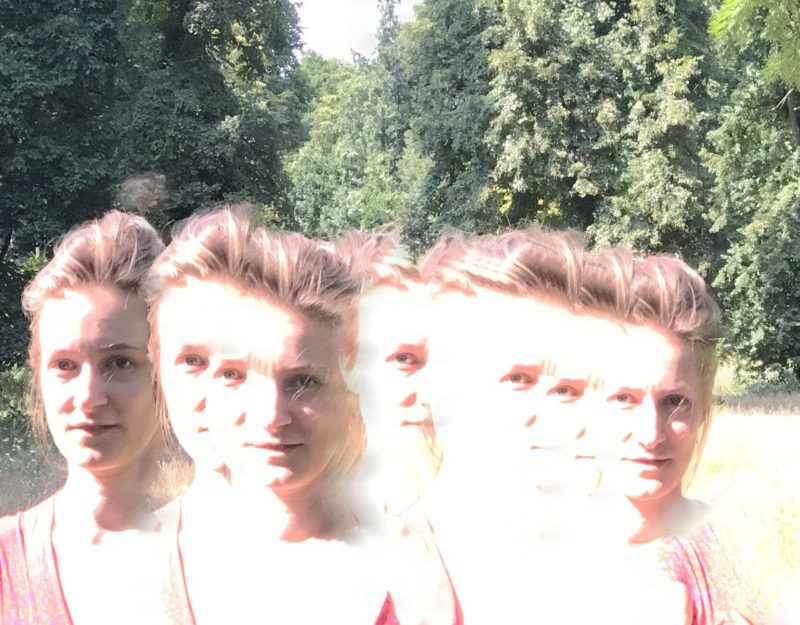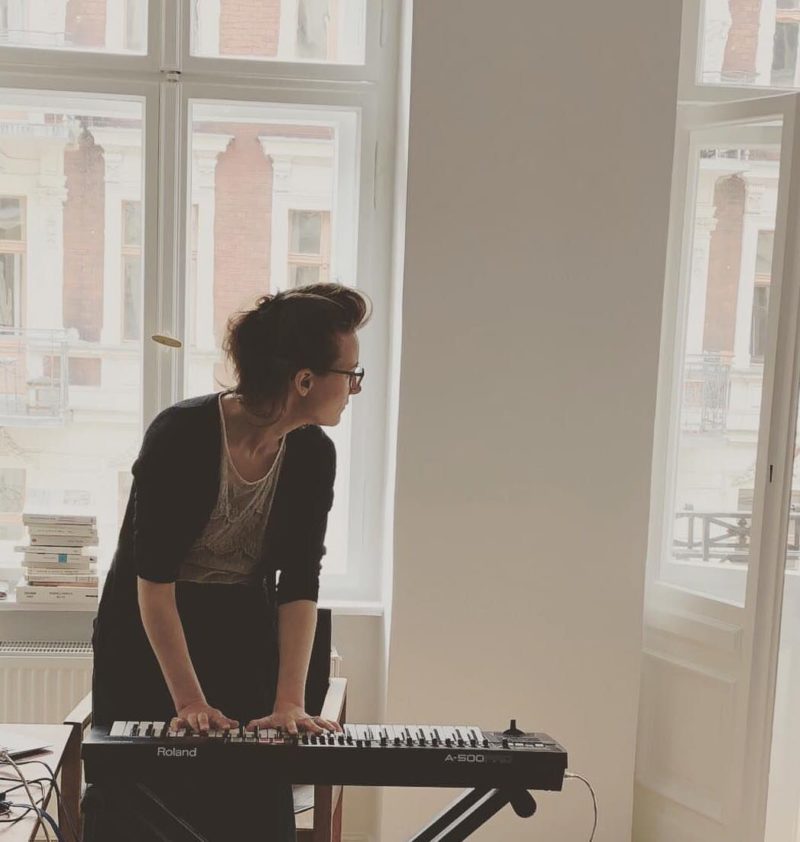Catherine Lamb

CC
I thought we could start by talking about what you have planned for your concert at Kraak.
CL
Yes, sure. Since they informed me that the concert is outdoors I decided to play my synth that filters the outside. It will be solo secondary rainbow synth.
CC
Can you describe what the secondary rainbow synth does?
CL
Microphones are set up, presenting the surrounding environmental field, and this concurrent image is used as real time subtractive synthesis. Resonant band pass filters are placed on frequencies, in this case a sequence of partials over 10 hz. For this performance/instance I play those frequencies on the keys of a midi keyboard, so it’s rather straightforward/simple. But they act as a kind of aeolian harp to what is happening, so that I can make a kind of filter organ to what is occurring.

CC
This idea of filtering the environmental sound is a really interesting development since our last interview (for your shade/gradient release). I find it interesting because your compositions are so much about being inside the sound of a particular tuning, of an ensemble acting like one large instrument or timbre in a way. So to bring the sounds of the environment into that is almost a way of turning that idea inside out or perhaps to complicate things, in a very beautiful way. The tunings you derive are very much like complete worlds, or closed systems, and your use of these filtering synthesizers seems to introduce a lot of elements that are somewhat out of your control or "already going on". Do you see it that way at all?
CL
Yes, but perhaps it is more that the closed systems (of the particular relational tunings) are a kind of ideal/conceptual space in which musicians are engaging/attempting towards that ideal space that is never actually possible to achieve in absolute terms. The closer one gets into the center of a point that fuses in absolute terms with another point, the more activated and expanded the space gets, while also getting closer and closer together as the musicians are fusing. So it is the action of attempting this space that also accounts for the chaotic world--unpredictabilities regarding how one is feeling that day, or how the instrument is responding, or how precise the materiality of the instrument is able to produce in clear terms, or how deep of a wave is occurring from breath or bow or pluck or strike (I feel like we're often out at sea, or taken by the wind, and trying to balance together in a central vortex of conceptual clarity) so that the closer and closer we get to it, the more our brain/body understanding fuses with the false/real physicalities of the world and we can complete those shapes in our own beings as perfect states, even within chaotic states. So there is this element that already exists when trying to find one's relational point with another's, let alone one self producing those points; but my use of the filtering synthesizer is to extend the filter from our innermost point and draw a connection into the outermost point, to find a thread between it all.
CC
Yes, beautifully put! I often think about this idea in relation to tuning or rhythm, that there is the conceptual ideal of a pitch or rhythmic space, but it's only activated by the human effort of trying to enact that space. The concept or ideal is like a grid, but the act of trying to do that in real time/space is more like a weaving that points toward a certain ideal, but has all the inconsistencies of its own unique warp and weft.
CL
Even when I try to hear these things electronically, there are still these waves interacting together in ways that you can't entirely predict. You can get closer and closer with measurements but how can you be in exact phase in space between points and not drift? This is impossible to achieve, only to touch it conceptually. New problems always emerge, no matter the situation you are in.
CC
You've been doing a lot of ensemble work recently. Last time I saw you we talked a little bit how playing solo perhaps wasn't your favorite way to express these ideas. Is filtering the environmental sounds via the secondary rainbow synth a way of perhaps being in dialogue with something outside yourself, even though you are playing solo? A kind of duet with the environment?
CL
Yes, exactly. Working with the unpredictability of what might occur I find quite fascinating and makes it less about myself within the chaos and more myself in direct interaction with the chaos by filtering it a certain way.
CC
How did you come up with the name for the secondary rainbow synth?
CL
Bryan (Eubanks) and I have a scientific book about the visible field lying around and we both were drawn to the description of the secondary rainbow, being a kind of residue or afterimage of the more dominant rainbow. So often people get excited about the word "rainbow" of course and call the synth "the rainbow synth" but that is overlooking the importance of the secondary relation of the faint outline that is usually present but not necessarily noticed.
CC
I spent a year living in New Mexico and the combination of summer rains and very intense light and altitude often produced what everyone called "double rainbows". But secondary does seem more precise - the inner rainbow is always more subtle, like an echo of the outer one. Can we talk about your Viola Torros project, with Johnny Chang?
CL
Sure. I am currently at Klangraum again in Dusseldorf (the program Antoine Beuger hosts every summer) and this is where the research into Viola Torros seemed to begin with Johnny. She - the anonymous composer - was the starting point of the project. Johnny asked me if I knew her work. At that time I didn't, but over the years we've been discovering her potential work, imagining her life and influences. Now she is very real to me and I am starting to understand her work, rendering her less and less anonymous.
CC
How much of her work exists and in what form? Scores, notation?
CL
We wanted to try to understand what might have influenced what: Was she Spanish? Did she travel in present day Iran? Was she born in India? We don't know. There is so much we don't understand about history, mostly because, as Euro-centrically trained musicians for most of our lives (Johnny and I), we were taught to think of the powers of European culture, even though the threads of knowledge and innovation are so confusing, so obviously taken from the greater world with longer histories in fact. Obviously the innovations in Indian Renaissance music could have spread far. We search for her fragments and know when we find them. We make realizations of those fragments.
CC
Sounds rather like trying to reconstruct Sappho's poetry, which were also songs.
CL
Antoine Beuger was talking about a community of nuns at the time of Corelli in Northern Italy. They were not allowed to perform publicly, so rather they freed themselves by developing their own insular musical institution. The music did not leave their cloister, but young women somehow knew about the great work that was happening there, and wanted to join so that they could compose as well. The cloister became quite large and quite respected, producing composers doing work unlike their contemporaries: innovative, unusual. But since this music was overlooked after their deaths - unlike the music of their male peers - it is as though the work became anonymous. Were they influential on outsiders? How will we learn this?